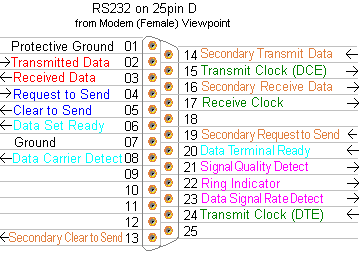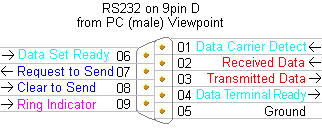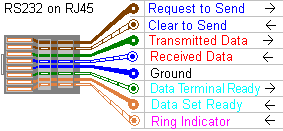| RS232 Summary | Standards - Latest revision EIA RS232F 1997 Similar to CCITT V24 / V28 |
RS232 Serial point to point links are normally used in ranges under 100 metres to carry text traffic.
Uses: modem links between computers. Links to "dumb" terminals & printers. Instrumentation & control.
Voltages - signals are bipolar, wires carry voltages of +/- 3 to 25
On the data lines "Mark" is -3 to -25 volts = "1". "Space" is +3 to +25 volts = "0".
Handshake lines use +3 to +25V to represent asserted and -3 to- 25V to represent negated.
Line drivers are current limited typically to 10mA. Signals tolerate shorting to others.
Most line drivers use the +/-12 volt rails in equipment and tolerate supply voltages to +/-15.
Receiver chips are tollerant to signal inputs of +/-30 volts.
Never plug RS232 into Parallel, SCSI or Ethernet ports; cables fit but the voltages damage equipment.
Connections - three types of plug are widely used. The 25 pin D was the original standard, but the 9 pin D is more common. RJ45 modular plugs are popular, the wiring shown seems typical for it.
DTE - Data Terminal Equipment (Computers, terminals instruments) normally uses male D plugs
DCE - Data Communications Equipment (Modems ) normally uses female D plugs
 | Control Circuits (Handshakes)
DTR and DSR establish a connection
RTS and CTS control data flow during a connection
Modem Indicators
| ||||||||||||||||
 | |||||||||||||||||
 |
Transfer speeds: Anything from 75 to 115,200 bits per second on the data lines. Transfer speeds are controlled by bit rate setting and hardware and/or software handshakes. The speed is often given as a "baudrate" - about two thirds of the bits transmitted are user data - the rest are control bits. Baudrate means all the symbols on the wire. Transfer speeds often don't include the control bits.
Maximum bit rate depends on cable length and capacitance. Cables 20-30 metres long typically run at 9600 baud or better. Cables 2 metres long may be OK at 57,600 baud or faster.
Setting speeds : Usually from drop-down lists in Windows programs and the command line in Linux (see /etc/termcap). Equipment such as machine tools and measurement instruments may have DIP switch or jumper settings and the manual will be needed. Speeds are usually multiples of 300 - 1200, 2400, 9600, 14,400, 19,200 38,400 etc
Almost all RS232 communication is asynchronous and uses a start bit, 7 or 8 data bits, an optional parity and some stop bits. This gives a handy abreviation sometimes called a frame type.
Frame types are often given an abbreviated specification with a Speed, Number of bits, Parity option and number of stop bits.
- 38Kb 8N1 is 38,400 baud, 1 start implicit, 8 data, No parity and one stop bit.
- 9600 7E1 is 9600 baud, 1 start implicit, 7 data bits, Even parity and one stop bit.
